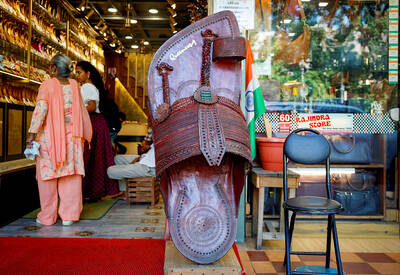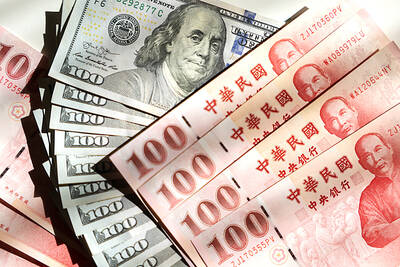English travel writer H.V. Morton once said he thought of London's National Gallery as an old friend he could drop by at will to enjoy his favorite works of art -- in small doses.
It is perhaps the way any technophile might feel about CeBIT, the world's top technology trade fair that opens a month earlier than usual this year, running between tomorrow and March 1.
And like London's warehouse of the aesthetic, where satisfaction comes in modest visual bites, at CeBIT there's a danger of an appetite "sickening and so dying" on gigabytes of high-tech fare without previous orientation.
The dimensions are awesome -- three times the size of its US rival Comdex in Las Vegas -- and continuing to grow.
At least 700,000 visitors this year are expected to stump, or to slump, through 26 halls where more than 7,000 exhibitors -- 3,000 from 63 nations other than the host country Germany itself -- brace themselves for the onslaught over a combined exhibition area of 408,839 square meters.
Taiwan tops Foreign Exhibitors League
And again this Silicon Island, for the third time in succession, heads the foreign exhibitor league table with 508 companies followed by the US, with 422, and the UK, with 312.
Taiwan's presence at CeBIT is a pretty accurate reflection, too, of the nation's economic and technological development through the past couple of decades.
In 1982, for instance, a single Taiwanese company attended. But this figure grew to 289 in 1995 and by 1998 surpassed even that of US exhibitors.
Considering host city Hannover in a cultural and historical context, CeBIT is also a reminder of the interdisciplinary nature of life in the 21st century, which is being made even more so by use and integration of digital technology.
And arguably, there's no better place and opportunity anywhere on the planet to catch up on the plethora of cyberspace-age products, concepts and trends it has spawned, not a few of them from Taiwan.
Organizers Deutsche Messe have at least made it a little easier for the visitor by arranging exhibitors into technology areas.
So there are halls for mobile and fixed communications, computer hardware, data networking and software as well as many areas of applications such as office automation and bank technology.
Taiwanese companies are spread through three of them, by far the largest group in the re-designed Pavilion 9 with the rest divided between Halls 12 and 13.
Connectivity, Communications and Cameras
Like the industry at large, the Taiwanese this year have crested the wave of USB (Universal Serial Bus Standard) with practically all their new products, from mini scanners to notebooks, using it for cabling and connectors.
An area where this is especially true is in the PC camera market. Up until now traditional connectors have been unable to cope with the higher data transfer speeds that video requires. Now, a Pocket PC Camera debuting at CeBIT with a progressive scan 0.25 inch CCD sensor and retailing for less than US$80, is Taiwan Addonics' answer to the problem.
What's more, the camera's unique stand means it can be folded flat and also attached to a notebook or PC monitor.
For sure then, on the USB front visitors to CeBIT 2000 will find that this technology may very soon exceed all other PC interfaces as the preferred plug-in, especially since the USB 2.0 specification is 40 times faster than USB 1.1.
As the first major IT fair of the new millennium, CeBIT 2000 is also a window on the new age of communication -- mobile communications in particular.
Even in this starry firmament of industry leaders, from Nokia, Motorola, Ericsson, IBM, Microsoft, Vtel, PictureTel and all the rest, the spunky Taiwanese blaze through with original variations on many themes.
The art -- or the artifice -- of course, is to niftily combine the PC and communications and come up with mobile computing and commuting solutions that grab market share as cannily as they capture images from streaming video, cameras or other video devices.
The Mini-Clip from Avigramm Technologies is a pretty little debutante in this category while Phonescape from AME includes a regular telephone handset with a PC camera, adding up to a video conferencing device that almost anyone can afford.
In more traditional sectors too, such as mainboards, graphics cards, notebooks and monitors -- where slimmer and more powerful are the trend -- the Taiwanese will be out there with mindblowing additions to a bevy of products that reaped a harvest of awards at Comdex last year.
Seems certain they'll be repeating the performance at CeBIT2000.

MARKET LEADERSHIP: Investors are flocking to Nvidia, drawn by the company’s long-term fundamntals, dominant position in the AI sector, and pricing and margin power Two years after Nvidia Corp made history by becoming the first chipmaker to achieve a US$1 trillion market capitalization, an even more remarkable milestone is within its grasp: becoming the first company to reach US$4 trillion. After the emergence of China’s DeepSeek (深度求索) sent the stock plunging earlier this year and stoked concerns that outlays on artificial intelligence (AI) infrastructure were set to slow, Nvidia shares have rallied back to a record. The company’s biggest customers remain full steam ahead on spending, much of which is flowing to its computing systems. Microsoft Corp, Meta Platforms Inc, Amazon.com Inc and Alphabet Inc are

Luxury fashion powerhouse Prada SpA has acknowledged the ancient Indian roots of its new sandal design after the debut of the open-toe footwear sparked a furor among Indian artisans and politicians thousands of miles from the catwalk in Italy. Images from Prada’s fashion show in Milan last weekend showed models wearing leather sandals with a braided design that resembled handmade Kolhapuri slippers with designs dating back to the 12th century. A wave of criticism in the media and from lawmakers followed over the Italian brand’s lack of public acknowledgement of the Indian sandal design, which is named after a city in the

The US overtaking China as Taiwan’s top export destination could boost industrial development and wage growth, given the US is a high-income economy, an economist said yesterday. However, Taiwan still needs to diversify its export markets due to the unpredictability of US President Donald Trump’s administration, said Chiou Jiunn-rong (邱俊榮), an economics professor at National Central University. Taiwan’s exports soared to a record US$51.74 billion last month, driven by strong demand for artificial intelligence (AI) products and continued orders, with information and communication technology (ICT) and audio/video products leading all sectors. The US reclaimed its position as Taiwan’s top export market, accounting for

INVESTOR RESILIENCE? An analyst said that despite near-term pressures, foreign investors tend to view NT dollar strength as a positive signal for valuation multiples Morgan Stanley has flagged a potential 10 percent revenue decline for Taiwan’s tech hardware sector this year, as a sharp appreciation of the New Taiwan dollar begins to dent the earnings power of major exporters. In what appears to be the first such warning from a major foreign brokerage, the US investment bank said the currency’s strength — fueled by foreign capital inflows and expectations of US interest rate cuts — is compressing profit margins for manufacturers with heavy exposure to US dollar-denominated revenues. The local currency has surged about 10 percent against the greenback over the past quarter and yesterday breached